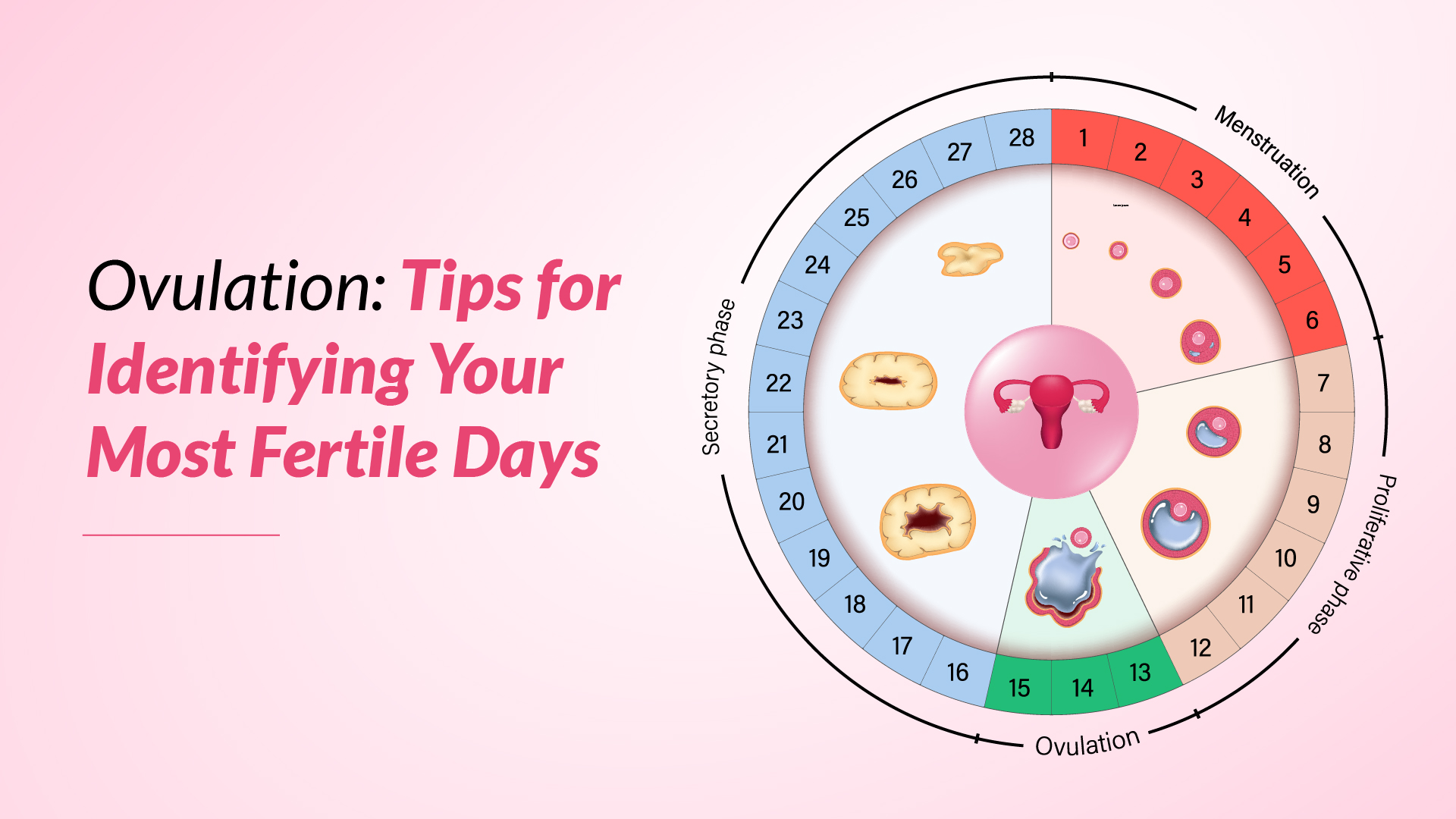Reviewed By: Dr. Sridurga N, fertility specialist at Ferty9 Fertility Clinic, Tirupati
Understanding the most fertile days in a menstrual cycle can double the chances of achieving pregnancy. For many women, identifying these crucial days feels like solving a complex puzzle, but it doesn’t have to be complicated. The key lies in recognising when ovulation occurs and planning accordingly. Learning to identify these fertile days through various tracking methods can significantly improve the chances of conception.
Related read: How Fertility Drugs Work: Boosting Your Chances of Conception
Understanding Your Menstrual Cycle
A typical cycle spans approximately 28 days, though this duration can vary from twenty-one to thirty-five days among women.
The menstrual cycle has distinct phases:
- Menstrual Phase: The cycle begins with menstruation, lasting 3-7 days
- Follicular Phase: The ovary prepares to release an egg
- Ovulatory Phase: The mature egg is released from the ovary
- Luteal Phase: The body prepares for possible pregnancy
During each cycle, hormones like oestrogen and progesterone work together to create an environment suitable for conception. These hormonal fluctuations trigger various physical changes that help identify the fertile window.
Related read: Menstrual Cycle and Fertility
What is Ovulation? and Why is It Important?
Ovulation marks a crucial milestone in the reproductive cycle when a mature egg gets released from the ovary. This process typically occurs around day 14 in a twenty-eight-day cycle, though the timing can vary significantly among women.
During ovulation, hormonal changes trigger the ovary to release a mature egg, which then travels through the fallopian tube. This released egg remains viable for approximately 24 hours, creating a brief but critical window for fertilisation.
Understanding ovulation is essential for conception because:
- The egg can only be fertilised during a specific 24-hour period
- Sperm can remain vital in the woman’s reproductive tract for 5 days
- Conception is most likely when intercourse occurs in the days leading up to ovulation
- The timing of ovulation determines the fertile window
- Regular ovulation indicates normal hormonal function
The release of an egg during ovulation is accompanied by several physical changes that women can track to identify their most fertile days. These changes include variations in body temperature, cervical mucus consistency, and hormone levels. By recognising these signs, women can better understand their bodies and maximise their chances of conception.
Related read: Focused on Fertility: Natural Ways to Increase Ovulation
What is the Fertile Window?
The fertile window represents the optimal time frame during which conception is most likely to occur. This crucial period spans six days in each menstrual cycle, encompassing the day of ovulation and the five days preceding it.
A woman’s peak fertility occurs during two specific days within this window:
- The day before ovulation
- The day of ovulation itself
The fertile window’s timing aligns with two biological factors: the egg’s 24-hour survival period after ovulation and the sperm’s ability to survive up to five days in the female’s reproductive tract. This combination creates the six-day window of fertility.
The probability of conception is approximately 33% when intercourse occurs during the two days before ovulation.
For women with regular cycles, the fertile window typically falls between days 10 and 15 of their cycle.
Tips for Identifying Your Most Fertile Days
Several reliable methods help women identify their most fertile days after period, each offering unique advantages for tracking ovulation. Understanding and implementing these methods can significantly improve the chances of conception.
Tracking Ovulation with Calendars
Calendar tracking provides a simple starting point for identifying the fertile window. Women can mark the first day of their period and count forward to estimate their most fertile days in cycle. This method works best for those with regular cycles, typically predicting ovulation around day 14 of a 28-day cycle.
Ovulation Prediction Kits
These scientific tools detect luteinising hormone (LH) surges in urine, signalling approaching ovulation. OPKs offer up to 99% accuracy in predicting ovulation, making them exceptionally reliable for identifying fertile days. Testing should begin several days before expected ovulation.
Monitoring Changes in Cervical Mucus
Cervical mucus changes throughout the menstrual cycle, providing natural fertility signals. During the most fertile period, cervical mucus becomes:
- Clear and stretchy, similar to egg whites
- More abundant than other times
- Slippery and wet in texture
Basal Body Temperature Method
This method involves measuring body temperature each morning before any activity. A slight temperature rise (0.2-0.5°C) indicates ovulation has occurred. While this method doesn’t predict ovulation in advance, it helps confirm ovulation patterns over time and identify the fertile window in future cycles.
What if I have Irregular Periods?
Irregular menstrual cycles present unique challenges for women trying to identify their fertile window. While standard tracking methods work well for regular cycles, women with irregular periods need different approaches to determine their most fertile days.
Women experiencing irregular periods should consider these alternative tracking methods:
- Using ovulation prediction kits more frequently throughout the cycle
- Paying closer attention to cervical mucus changes
- Maintaining daily basal body temperature readings
- Recording physical symptoms like breast tenderness or mild cramping
Professional medical guidance becomes particularly important for women with irregular cycles. Doctors can help identify underlying causes and recommend appropriate tracking methods. They may suggest additional tools such as hormone testing or ultrasound monitoring to determine the ovulation period for pregnancy precisely.
Women with irregular cycles should start tracking their periods for at least three months to identify any patterns. This information helps doctors assess cycle variations and recommend suitable fertility monitoring approaches. Some women might benefit from hormonal treatments to regulate their cycles, making it easier to predict their fertile window.
How else can I Prepare for Pregnancy?
Preparing for pregnancy involves more than just tracking the ovulation window. A comprehensive approach to preconception health can significantly improve the likelihood of conception & support a healthy pregnancy.
Women planning for pregnancy should begin preparations 3-6 months before trying to conceive. Essential steps include:
- Scheduling a preconception check-up with a doctor
- Starting prenatal vitamins with folic acid
- Maintaining an optimal body weight through balanced nutrition
- Exercising moderately for 30 minutes most days
- Reducing caffeine intake to 200mg or less daily
- Eliminating alcohol and tobacco use
- Managing existing medical conditions
- Updating vaccinations
- Getting adequate sleep (7-9 hours nightly)
- Reducing stress through relaxation techniques
Beyond tracking the most fertile days, women should ensure their bodies are in conditions favourable for conception. This includes maintaining regular medical check-ups and addressing any underlying health concerns. A diet rich in fruits, whole grains, vegetables & lean proteins provides essential nutrients for fertility and early pregnancy. Staying hydrated and maintaining regular physical activity supports reproductive health and overall well-being.
Find Hope and Solutions for Female Infertility and Male Infertility — Explore Our Comprehensive Services
IVF Treatment
IUI Treatment
ICSI Treatment
PICSI Treatment
Fertility Preservation Service
Blastocyst Culture & Transfer Treatment
Genetic Screening & Testing
Conclusion
Success in conception comes from combining knowledge about fertility with overall health preparation. Each woman’s reproductive journey differs, making it essential to find the right combination of tracking methods and lifestyle changes that work best for her specific needs. Armed with this understanding, women can approach their fertility journey with confidence and increased chances of achieving pregnancy.
Visit Our Clinic:
Fertility Clinic in Hyderabad
Fertility Clinic in Visakhapatnam
Fertility Clinic in Vijayawada
Fertility Clinic in Warangal
Fertility Clinic in Rajahmundry
Fertility Clinic in Tirupati
Fertility Clinic in Kurnool





